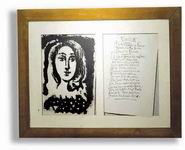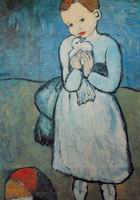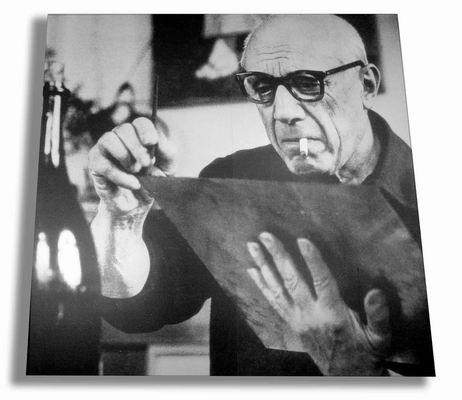Shanghai Daily news




Huge photographs of Pablo Picasso in scenes
from ordinary life and his prints are displayed at Asia¡¯s biggest-ever
single showing of the master¡¯s original works in Shanghai, as part of the Year
of France in China. (Photo: Shanghai Daily)
The largest-ever exhibition in Asia of artworks by Pablo Picasso is
now open in Shanghai. Wang Jie reviews the exhibition.
The large collection
of artworks by Pablo Picasso (1881-1973) now on display in Shanghai ¡ª a total of
265 prints ¡ª is still only a drop in the ocean compared with his prolific output
during his long career as one of the world¡¯s most famous artists.
But now
that they have been put together in one exhibition ¡ª they make up the biggest
single showing of original prints by Picasso ever to be held in Asia.
As part
of the Year of France in China, all the works in the exhibition are on loan from
the Francebased Picasso Foundation.
¡°This is a rare opportunity for visitors
to appreciate the master¡¯s artworks,¡± says Zhang Wen, one of the organizing
staff at the Shanghai Urban Planning Exhibition Hall, where the exhibition is
running. ¡°It is even impossible for Europeans to see such a large number of
Picasso¡¯s original prints in one exhibition.¡±
Divided into eight sections,
the monthlong exhibition is a wideranging look at Picasso¡¯s impressive artistic
output. And one, the ¡°Three-Cornered Hat¡± created in 1920, is on public display
for the first time. Huge photographs showing the master in scenes from ordinary
life are hung in the hall and take viewers closer to the artist¡¯s life and work.
However, the prints on show are small in size that need to be looked at
carefully. Some consist of a few lines only, revealing the artist¡¯s confidence
and ¡°artlessness.¡±
"I am a big fan of Picasso,¡± says Tony Wang, a
30-something whitecollar worker. ¡°Although some of his great works are still
stored in overseas museums, this show at least is a special treat for me.¡±
Perhaps for many local art lovers, the exhibition is a bit too academic, in
particular when reading the different descriptions of the sophisticated printing
techniques that are placed under the works.
However, if one reads the
introduction to the artworks carefully, the inspiration that led to the creation
¡ª from poetry, drama or myth ¡ª can be detected and understood.
Born in
Malaga in Spain, Picasso was the son of an academic painter and he began to draw
at an early age. In 1895, the family moved to Barcelona where Picasso held his
first exhibition five years later.
He was fortunate in becoming, as no
painter or sculptor before or since has been able to become ¡ª not even
Michelangelo ¡ª as famous as he was in his own lifetime. Among the 60,000 art
pieces that Picasso left to the world are universally remembered images that
have influenced other media, such as photography, movie and television.
Although Marcel Duchamp has certainly had more influence on nominally
vanguard art over the past 30 years, Picasso was the first artist to attract the
obsessive attention of the mass media. His restless changes of style and his
constant pushing of the boundaries of art always caused much controversy and, at
the same time, made him a celebrity again and again.
A biography of Picasso
at the entrance traces the artist¡¯s development from his Blue Period (1901-04)
and Rose Period (1905) to his pivotal work, ¡°Les Demoiselles d¡¯Avignon¡± (1907),
and the subsequent evolution of Cubism from the Analytic Phase (1908-11) through
to the Synthetic Phase (1912-13).
But for most local visitors, these academic
terms are unfamiliar. They are more interested to see the burning emotion
contained in the ¡°Spanish bullfighter.¡±
A series prints of bullfighting
scenes are reminiscent of traditional Chinese ink-wash paintings because Picasso
used succinct brushstrokes in outlining the critical points.
Picasso was not
a philosopher or a mathematician. For him, reality is not just figure and space
but is all relationships.
And surely the most powerful element in Picasso¡¯s
work is sex. The female nude was his obsessive subject. Everything in his
pictorial universe seems related to the naked bodies of women. Picasso imposed
on them a load of feeling, from dreamy eroticism to a sardonic but frenzied
hostility.
¡°To displace,¡± as Picasso described the process, ¡°to put eyes
between the legs, or the sex organ on the face. To contradict. Nature does many
things the way I do, but she hides them! My painting is a series of
cock-and-bull stories.¡±
Date: through March 2, 9am-4pm
Address: 100 People¡¯s
Ave
Admission: 40 yuan
Tel: 6318-447



